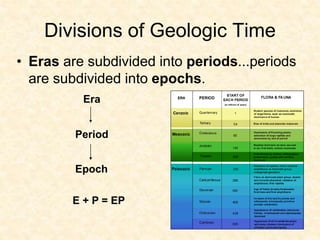
2.ppt
- 1. Divisions of Geologic Time • Eras are subdivided into periods...periods are subdivided into epochs. Era Period Epoch E + P = EP
- 2. 4 -Eras 4. Cenozoic (recent life) – 65 Ma through present day 3. Mesozoic (middle life) – 250 Ma…lasted 180 Ma 2. Paleozoic (ancient life) – 542 Ma…lasted 300 Ma 1. Precambrian/Azoic – 88% of earth’s history Entire time before 542 Ma (542-4600 Ma)
- 3. Major events in different Eras
- 4. Heard of Pangaea? the supercontinent that included all continents on Earth. It began to break apart c. 175 Ma.
- 5. But before Pangaea, Earth’s landmasses ripped apart and smashed back together to form supercontinents repeatedly. This cycle has been going on for the last 3.0 Ga.- regulating our planet’s geography, climate, and carbon cycles.
- 7. Paleozoic Era begins with the breakup of the Rodinia.
- 8. The beginning of Paleozoic Era Cambrian (542-485 Ma) Named after Cambria, the Roman name for Wales, where Adam Sedgwick, one of the pioneers of geology, studied rock strata. Charles Darwin was one of his students. (Sedgwick, however, never accepted Darwin's theory of evolution and natural selection.)
- 9. Life in Paleozoic • Explosion of life in the oceans began during this era. The Cambrian Period (542-485 Ma) is the “Age of the Trilobites” • Most of the continents were covered in warm, shallow seas. – Invertebrates dominant – Trilobites, Brachiopods – Fish emerged – Early land plants including mosses, ferns and cone-bearing plants. – The early coal forming forests were also formed during this time. – Fish led to the arrival of amphibians The Carboniferous Period (360-300 Ma) is called the “Age of Amphibians”
- 10. Trilobites • Lived in Earth’s ancient seas • Extinct before the dinosaurs came into existence • Cambrian Period is know as the “Age of the Trilobites”
- 11. Brachiopods • Marine animals that resemble clams.
- 12. Early Fish Early fish had no jaws Cambrian Sea monster (National Geographic)
- 13. Early Land Plants Cone bearing plants Ferns Mosses
- 14. The Appalachian mountains were formed during Paleozoic (480 Ma- Ordovician Period). Major tectonic event during Paleozoic
- 15. End of Paleozoic Era • Paleozoic closed with the formation of Pangaea, as the Earth's continents came together once again.
- 16. The end of Paleozoic Era • largest mass extinction in history wiped out approximately 90% of all marine animal species and 70% of land animals. – Possible causes of this Mass Extinction Event • Lowering of sea levels when the continents were rejoined as Pangaea (convergent boundary) • Increased volcanic activity (ash and dust) • Climate changes – cooler climate
- 17. Mesozoic Era – Middle Life • At the beginning of this era the continents were joined as Pangaea. • Pangaea broke up around the middle of this era.
- 18. Mesozoic Era • Reptiles: Most abundant because of their ability to adapt to the drier climate. • Dinosaurs: – First small dinosaurs appeared in the Triassic Larger and more abundant dinosaurs appeared in the Jurassic Period. • Small mammals and birds also appeared during this era. – The mammals were small, warm-blooded animals. Hair covering their bodies.
- 21. Mesozoic Mammals
- 23. Mesozoic Plants Flowering plants evolved towards the end of the Mesozoic Era.
- 24. End of Mesozoic Era • Mass extinction event about 65 million years ago. – Many groups of animals, including the dinosaurs disappeared suddenly at this time. • Many scientists believe that this event was caused by a comet or asteroid colliding with the Earth.
- 25. End of Mesozoic Era Mass Extinction Event • Asteroid or Comet collides with Earth. – Huge cloud of smoke and dust fills the air – Blocks out sunlight – Plants die – Animals that eat plants die – Animals that eat plant-eaters die. • However, not all forms of life were extinct. • Many animals today are descendants from the survivors of this extinction event.
- 26. Cenozoic Era – Recent Life • Began about 65 million years ago and continues today – Climate was warm and mild. – Marine animals such as whales and dolphins evolved. • Mammals began to increase and evolve adaptations that allowed them to live in many different environments – land, air and the sea. – Grasses increased and provided a food source for grazing animals • Many mountain ranges were formed: – Alps in Europe; Himalaya in India; Rocky Mountains in the USA
- 27. Tectonics in Cenozoic Himalaya, Alps https://www.edumedia-sciences.com/en/media/565-formation-of-the-himalayas Alps (34-24 Ma) Oligocene-Miocene
- 28. Cenozoic Era • Growth of these mountains may have helped to cool down the climate – Ice Ages occurred late in the Cenozoic Era (Quaternary Period). • As the climate changed, the animals had to adapt to the rise and fall of the oceans caused by melting glaciers. • This era is sometimes called the “Age of Mammals”
- 29. Cenozoic Era • Marine animal examples: – Algae, Molluscs, Fish and Mammals • Land animal examples: – Bats, Cats, Dogs, Cattle and Humans – Humans are thought to have appeared around 3.5 million years ago (during the most recent period – Quaternary). • Flowering plants were now the most common plant life.
- 30. Cenozoic Mammals
- 31. Flowering Plants were common during the Cenozoic Era
- 32. Today • Today we are in the Holocene Epoch of the Quaternary Period of the Cenozoic Era. Which unit is the largest? Which unit is the smallest?